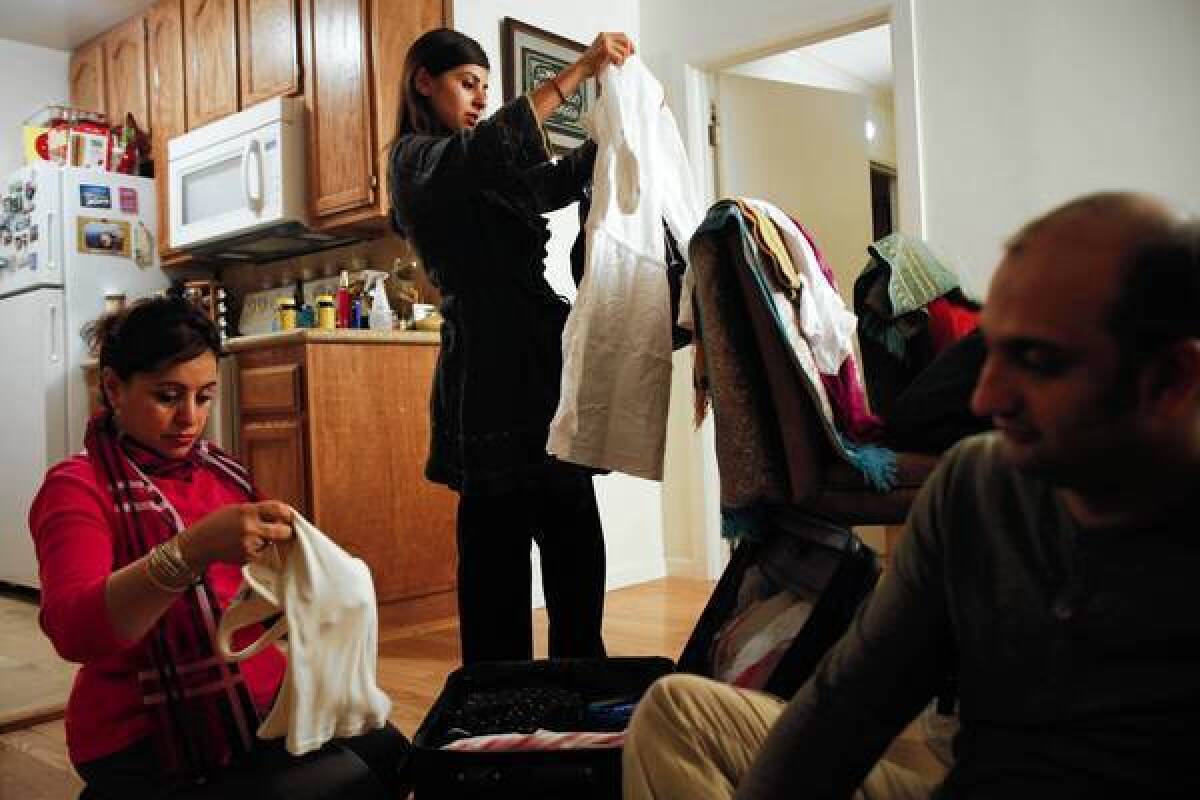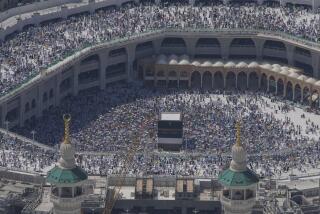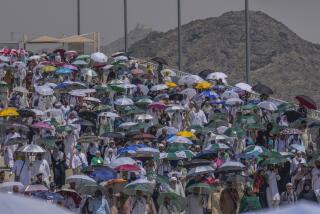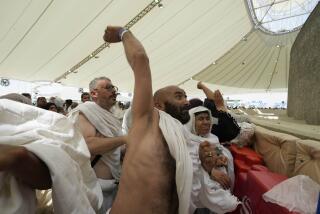Virus hangs over Islamic pilgrimage to Mecca

After they got married last year, Homaira and Jahan Hamid decided they would embark on the hajj pilgrimage to Saudi Arabia âas soon as possible,â before parental duties began to crowd out their religious obligations.
When the Northridge couple discovered that a mysterious and sometimes deadly virus had emerged in the desert kingdom, killing more than 40% of the people it was known to have infected, they briefly reconsidered.
The hajj â which every able Muslim must attend at least once in their lives â annually draws to Mecca as many as 3 million people, all gathered together. Last Friday, the Hamids boarded a long-planned flight to the region, stowing surgical face masks and vitamins along with their clothing and other essentials.
âWeâre just kind of hoping for the best,â Homaira Hamid said.
Thatâs a sentiment shared by pilgrims and public health officials alike, who say they will stay vigilant over the next month or so as people return home from the holy cities of Mecca and Medina.
Doctors and emergency departments in Southern California, per instructions from local and state departments of public health, will be on the lookout for fevers, respiratory woes and other telltale signs of illness in people whoâve recently traveled from the region.
Severe coughs or flu-like symptoms could be a sign of infection with the Middle East Respiratory Syndrome Coronavirus, or MERS-CoV, as the virus is known â and an indication that the infection, thus far detected only in the Middle East and Europe, had spread to the U.S.
Or such symptoms could be nothing significant, just the typical illnesses pilgrims pick up every year during the crowded hajj.
âYouâll always have something when you come back,â Jahan Hamid said.
The hajj, which typically draws more than 10,000 from the U.S. and culminates Oct. 15 this year, is just the sort of environment where a virus can spread efficiently.
Conditions can be hot and crowded, said Jihad Turk, a religious advisor for the Islamic Center of Southern California in Los Angeles and president of Bayan Claremont, an Islamic graduate school in Claremont.
Pilgrims retrace the steps of the biblical Abraham, his wife Hagar and their son Ishmael, considered the founders of the Islamic people. In one key ritual, they march seven times around the cube-shaped Kaaba in Mecca, said to have been built by Abraham and Ishmael.
âYou have a million people all at the same time walking around the Kaaba,â said Turk, who has participated in the hajj twice. âItâs like being in a crowded subway in New York for hours and hours at a time.â
People attending hajj expect to get sick, he added. Some joke about catching âhajj fluâ â a cold and cough that lingers, but then usually resolves on its own.
No one knows if pilgrims will get sick with MERS.
Scientists first detected MERS â a virus similar to SARS, which sickened more than 8,400 and killed more than 800 during a 2003 outbreak â in 2012. Last Friday, the World Health Organization reported that MERS was confirmed to have infected 136 people, 58 of whom had died from respiratory distress and organ failure.
Researchers have struggled to understand the virus: what animal it may have emerged from, how it spreads from person to person, and why it affects some patients, including many with preexisting conditions, especially severely.
The U.S. Centers for Disease Control and Prevention and the World Health Organization have convened special committees to monitor the threat. But aside from encouraging older people, children, pregnant women and people with compromised immunity not to attend hajj this year, neither body has urged travelers to change their plans.
Figuring out how loudly to sound the alarm about a virus like MERS â which, while deadly, has not yet proved to be widespread â can be a puzzle for health authorities, said Dr. Myles Druckman, senior vice president for medical services at International SOS, a company that provides medical advice and services for corporations.
âItâs still very unclear what direction itâs going,â he said. âIt makes for a difficult story, even for health authorities. You have to find that balance between being too aggressive in your communications and being too light about it.â
For now, health agencies are urging pilgrims to take basic precautions: Wash hands and be aware of sick people you may encounter. If you do wind up sick, tell medical professionals youâve just returned from the Middle East, and try to avoid exposing others around you to the virus.
Some, like the Hamids, will take masks in their bags. But Turk, who wore a mask part of the time while traveling in Saudi Arabia earlier this year, said he believed many pilgrims, following orders from religious advisors, would not want to cover their faces.
âIf the imam tells you if you wear this it will nullify your hajj, people wonât wear it,â he said. âMost people would want to err on the side of caution in terms of making it count.â
Jahan Hamid said he planned to wear his mask some of the time; his wife, who doesnât face the same religious restrictions, said she planned to wear her mask throughout their trip.
The real work fighting MERS could begin if pilgrims like the Hamids return to California and develop a âhajj fluâ that seems worse than the usual bad cold.
Then, said Los Angeles County Department of Public Health Director Dr. Jonathan Fielding, local doctors and emergency departments will be on the lookout for suspicious coughs and fevers.
âWe have procedures in place to get to the state lab any specimens that we think might be a problem,â Fielding said. âWe donât have any specific treatment, so itâs really important that we remain vigilant.â
More to Read
Sign up for Essential California
The most important California stories and recommendations in your inbox every morning.
You may occasionally receive promotional content from the Los Angeles Times.











